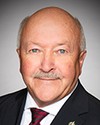Thank you very much.
Good afternoon to everyone in the room. I am sorry that I can't be there with you. It's a pleasure and an honour for me to be speaking to you today about my perspective on climate change.
I work at Ouranos on climate change adaptation, and more specifically on the physical risks that will affect infrastructures. I have a PhD in environmental science and a working background in oceanography. I've also worked under several contracts on behalf of the ministère des Transports du Québec.
In the brief I sent to the clerk, there are details about the position I hold today. I will explain a few of the reasons for my opinion on climate change adaptation and on the serious and irreversible changes that are affecting the climate and oceans.
I'd like to remind you that combatting climate change requires a two-part strategy, to simultaneously reduce greenhouse gases and adapt to inevitable climate change. Such adaptation requires the deployment of a set of initiatives and measures to reduce the vulnerabilities of critical infrastructures and strengthen the resilience of natural and human systems to the expected impacts. To strengthen this resilience, planning, preparation and prevention are becoming increasingly affordable compared to simply reacting to climate change consequences and waiting to see what happens.
In the transportation sector, we know that interim modality is important to reduce GHGs. However, it's also essential to build in the growing climate risks that amplify physical risks. Infrastructure management needs to be transparent and well-planned.
In the context of continued climate evolution, it's important to adopt a flexible approach that can adapt over time in keeping with the scale and pace of changes in climate conditions. If this approach is to lead to a well-informed decision, it needs to be based on robust research and development and on tools that incorporate risks and adaptation measures. In an approach of this kind, costs and benefits are also factored in, along with the positive indirect impacts of adaptation solutions, thereby creating opportunities for economic development.
It's important to act in a highly coordinated manner when decisions are being made by the various levels of government. The transportation sector is a cornerstone of resilient asset management. As one of the leading sectors in the country, it needs to follow best practices.
I will now describe five more specific recommendations with respect to the changes being proposed to the Canada Marine Act.
First of all, the concept of adaptation measures needs to be added in the preamble to the environmental regulations.
Enhanced synergy is also required between climate change plans and plans for the adaptation measures by using the superordinate expression “climate change”. These plans need to adopt common assumptions and there must be synergy between them. Combatting climate change does not simply amount to reducing greenhouse gases and the expression “climate change” is preferable because it is more generic.
I would also suggest that you look at the work being done by the task force on climate-related financial disclosure, which identifies several levels of adaptation measures.
For consistency's sake, it's important to acknowledge the regulatory changes being made for physical risk disclosure, in terms of placing an emphasis on resilient management of infrastructures with a view to establishing genuine climate and environmental leadership rather than simply searching for short-term solutions.
The final recommendation on climate change proposed in the Canada Marine Act is to more clearly illustrate the desired efficiency in multilevel coordination mechanisms by placing an emphasis on regional adaptation, which was promoted by Natural Resources Canada in its adaptation platform.
As for the changes proposed to the Railway Safety Act, I would first recommend more explicitly prescribing a knowledge of future climatic ups and downs in order to be able to do a more effective job of identifying them as physical climate risks.
Consideration must also be given to including the concept of a risk acceptability threshold and triggering sustainable transformation of certain rail lines to reduce risks equitably. There are areas that have a high level of exposure, and sometimes the solution is to move some lines to a risk-free zone. Of course, it would be impossible to do so across the country at the same time.
The final recommendation…




